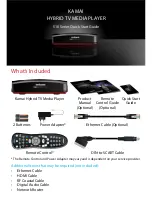
Manual Number: M501-2855
April 19, 1996
Revision (960419-1)
GENERAL:
The ST-146 is a miniature surface-mount version of our popular
ST-104 CTCSS Encoder/Decoder it features a universal design for
easy interface to most radio squelch circuits, end is small enough
to be mounted in a mobile or portable radio where space is limited.
Like the ST-104, the ST-146 is fully compatible with all major
CTCSS systems, including Motorola "Private Line", General
Electric "Channel Guard", and E.F.Johnson "Call Guard".
Due to surface-mount construction and our comprehensive
warranty policy, field repair is usually not cost effective. Complete
technical documentation is available through our applications
department for customers with special requirements.
Application information is available or can be developed for most
radio models. If you would like application details for a specific
radio, please call us TOLL FREE at (800) 227-0376.
ADJUSTMENTS
Frequency:
The ST-146 is CONTINUOUSLY tuneable over the standard
CTCSS frequency range from 67 to 250.3 Hz. To set the
frequency, apply power, set R33 fully clockwise and connect the
Tone Output lead (WHT/GRN) to your frequency measuring
equipment Adjust R10 for the desired CTCSS frequency. You may
find the use of a lissajous figure with a known on-frequency
reference the quickest set-up procedure, or as an alternate if a
frequency counter is not available.
Output Level:
The Tone Output level is adjusted with R33. Adjust R33 for
approximately
±
750 Hz deviation.
INSTALLATION
Mounting:
Use of a double-sided adhesive pad eliminates hardware
requirements. Mount the ST-146 on a clean, dry surface, oriented
to allow easy routing of the wiring to the radio. Press firmly after
mounting to ensure good adhesive contact. Do not touch the
adhesive or attempt to re-position the unit after mounting. The
ST-146 has been designed for maximum immunity to RF
interference; however, you should locate the unit as far as
possible from the radio's RF power stages. To further minimise
RF problems, twist the RED and BLACK leads together and
maintain all leads at minimum length.
Radio Interface:
The interface between the ST-146 board and the radio is by 13
wire leads on a miniature low profile connector. Most
applications will not require the use of all leads. Unused leads
should be removed from the connector by carefully lifting the
small tab near each connection pin and pulling the wire from the
connector. We recommend this method (rather than cutting
wires) because it allows reusing pins if an error is made.
[9] Negative (-) Supply (BLACK): Connect to System (-)
(Ground)
[3] Positive (+) Supply (RED):
Connect to (+) Supply ( 5.5Vdc
to 16Vdc)
[13] Encode Output (WHT/GRN): Most F.M. two-way radios
make provisions for CTCSS modulation. This point is generally
after the speech modulation limiter, and near the voice deviation
control. The impedance at this point varies from radio to radio.
Three parallel resistors (1K, 51K, & 150K) are in series with the
ST-146 output circuit, and the 1K and 51K resistors may be
eliminated from the circuit by removal of JU4 and or JU5.
Remove JU4 orJU4 and JU5 to provide a correct tone level
without loading the radio modulator circuit and reducing voice
modulation. A CTCSS deviation level of
±
750 Hz is
recommended.
[12] Tone Input (GREEN):
Jumpered to Hi-Pass Filter input by
JU1. Connect directly to the FM receiver detector audio output.
Breaking the audio path at this point will allow insertion of the
Hi-Pass Filter. If it is not practical to break the audio path at this
point, refer to Hi-Pass Filter input (BLUE).
[11] Hi-Pass Filter input (BLUE):
Use only when Tone input
(Green) cannot be used for Hi-Pass Finer input. Remove JU1 for
applications where breaking the audio path at the FM receiver
detector is not practical Hi-Pass Filter input audio should be
taken at the most convenient point
SELECTONE INC.
••
3501 BREAKWATER AVE
••
HAYWARD, CA. 94545-3610
(510) 781-0376
••
NATIONWIDE TOLL FREE (800) 227-0376
••
FAX: (510) 781-5454 E-MAIL admin@selectone.com
Operating Instructions
MODEL ST-146 Micro-Miniature
CTCSS Encoder/Decoder





















